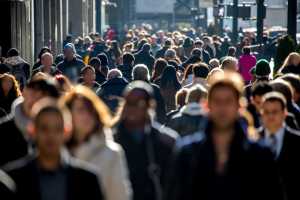There’s an old woman sitting on a bench, sobbing loudly into her hands. Surrounding her are countless people: a man sitting on the bench next to her, a few people standing at a nearby bus stop, and many walking right by. While some clearly notice the distressed woman, nobody asks her if she’s okay—while some clearly feel bad for the distressed woman, nobody asks if they can help.
The most likely explanation? The bystander effect. Also known as bystander apathy, the bystander effect is the phenomenon in which people are less likely to offer help in instances when others are present. The greater the number of people present, the less likely any individual is to step in.

What Is the Bystander Effect?
The bystander effect is when an individual is prevented from or discouraged from taking in action in a crisis situation due to the belief that the other bystanders in the group will engage in the situation and handle it, thus causing no one to intervene and the crisis to continue.
More specifically, the bystander effect occurs when a group of individuals are witnessing an event that would prompt intervention as a social norm (a medical emergency, assault), but the presence of another person who is actively witnessing the event prevents/inhibits a person from being willing to intervene and assume responsibility in the scenario. It can occur in large groups or even between two people.
What Is the Explanation of the Bystander Effect? Why Does It Occur?
There are a few reasons for this effect: one, an individual doesn’t feel responsible or obligated to help someone when there are others around who could help; two, an individual assumes that someone has already offered to help the person in need or will offer to help them; three, an individual often feels the need to behave in a socially acceptable way, so they are deterred from helping if that route has not been taken by another.
It sounds strange, but the bystander effect can make it feel embarrassing or dangerous to help someone in need when others do not, even causing certain amounts of social anxiety that lead to inaction.
People can tend to come up with these conclusions due to the natural human social assumption that there is “always someone more responsible” in the group that will take necessary action. This also has evolutionary implications, as aiding in a crisis or prompting situation inherently puts the individual at risk—it’s much easier and safer to remain within the group than to step forward into potential danger.
What Are the 5 Stages of the Bystander Effect?
There are five notable steps that occur in a situation that produces the bystander effect, processes raised in “The Unresponsive Bystander: Why Doesn’t He Help?” by Bibb Latané and John M. Darley (1970). These are:
- An event captures the attention of the individual.
- The individual evaluates the emergency (assess how many people are around, the severity of the emergency).
- The individual evaluates the presence and actions of fellow group members and decides on their personal responsibility to engage or not engage to help.
- The individual weighs their own competence against their motivation to engage in assistance (i.e., “Do I have the adequate training and experience to ensure a successful outcome here?”).
- The individual then makes a decision as to whether or not to engage in help or assistance.
What Would You Do?
Many like to think that they would help someone who needs it without question, despite the amount of onlookers present. However, the reality is much different when they actually find themselves in the situation.
ABC’s television show “What Would You Do?” is a hidden camera show that tests individuals when they are in these circumstances. It features actors who act out a given conflict or activity in a public area, and focuses on the actions of the bystanders surrounding the scene. Some remove themselves from the situation or pretend not to notice, but others show true courage by intervening and helping whoever appears to need it.
Once the scene has played out, the show’s host, John Quinones, steps in and talks to the people who surveyed the situation going down as well as those who intervened. Viewers at home watch as individuals discuss different reasons for avoidance or interference: Some felt as if they had no other choice but to step in, while others (thanks to the bystander effect) explained they felt it wasn’t their place or duty to.
What Is the Difference Between the Bystander Effect and Diffusion of Responsibility?
The bystander effect and diffusion of responsibility have many similarities, but are ultimately different psychosocial phenomena. The bystander effect occurs when two or more individuals are present and have their attention captured by a triggering event or situation.
Diffusion of responsibility, however, is a phenomenon which acts as a mediator or a tenet of the bystander effect. Diffusion of responsibility states that the more people there are witnessing a potentially traumatic event, the less likely they are to intervene.
This is due to the fact that others assume that, for example, within a group of 50 people witnessing someone being stabbed, that at least one person has alerted the authorities. Unfortunately, the higher the number of people in the group, the more diffuse they feel that it is their personal, individual responsibility to intervene.
Have There Been Research Studies Done on the Bystander Effect?
Yes, much research has been done regarding the bystander effect. One of the largest studies that was conducted after Kitty Genovese’s murder in the 1960s was a product of the book mentioned above: The Unresponsive Bystander: Why Doesn’t He Help? (Latané & Darley, 1970).
This study aimed to better understand and explain this phenomenon. Though the bystander effect had existed for centuries prior to the murder of Kitty Genovese, that case shocked the nation and prompted further research and inquiry as to how she was murdered with so many witnesses that did nothing. Many other research studies have spawned from the one above, but this was the original study that gave us the term “bystander effect”.
Though the bystander effect is a hard thing to resist, much like other mental health conditions or challenges, it may be helpful to simply know what is at work in your brain as it happens: what you’re feeling, and what is causing it. When you experience the bystander effect, instead of not understanding what you’re feeling or assuming that the reasons running through your mind not to help are all purely logical, you’ll now be able to recognize them as signs of the bystander effect. Hopefully, this knowledge alone might help you take more definitive action in a perilous situation.













